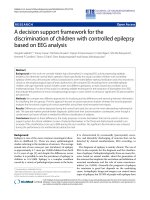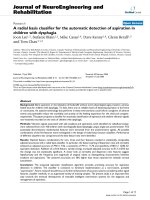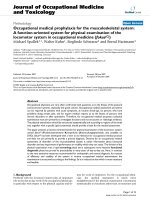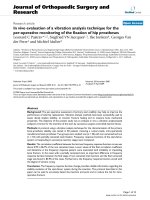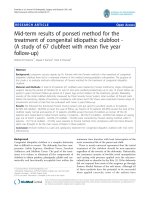A variable separation method for the calculation of the reliability of construction
Bạn đang xem bản rút gọn của tài liệu. Xem và tải ngay bản đầy đủ của tài liệu tại đây (519.27 KB, 6 trang )
Vietnam Journal of Mechanics, NCST of Vietnam Vol. 23, 2001, No 3 (167 - 172)
A VARIABLE SEPARATION METHOD FOR
THE CALCULATION OF THE RELIABILITY
OF CONSTRUCTION
NGUYEN VAN PHO
University of Civil Engineering
ABSTRACT. In this paper, a variable separation method for determining the reliability
of construction is proposed. Therefore, the reliability is a multiflication of two probabilities:
The probability of the occurrance of load and the probability of construction in the condition
the load has a determined value.
1. Introduction
Linearization method and iterative method have been used in the reliability
theory for determining the safety probability Ps or the reliability index /3.
But it is not applicable; in many important problems, because of the great value
of standard deviations or deficiency of characteristic probabilities of some random
variables.
Some simple cases of variable separation method were considered in (1, 2].
In this paper, a variable separation method for determining the safety probability
Ps in construction is proposed.
For illustration, a simple axample is considered.
2. Some existing methods for determining the safety probability
2.1. Linearization method [3]
Let the safety margin M be non-linear and given by
M = f(x) =
f (x1, X2, ... , Xn),
(2.1)
where xi are basic variables.
Then by expanding M in a series about the linearization point
r o o ... ,xno]T
x o = LX1,X2,
(x 0 is usually chosen as the expectation point) and retaining only the linear terms
one gets.
(2.2)
167
· ·
wh ere t h e d envat1ves
xg.
81
~
UXj
j = 1, 2, . . . , n, are evai uat ed. at t h e i inearization point
Approximate values for the mean value µMand the standard deviation
be calculated from (2.2).
aM
can
(2.3)
(2.4)
Finally, the reliability index
/3
is defined from (2.3) and (2.4) by
/3 =
µM.
The one - one relation between the probability of failare P1 and reliability index
is
/3
(2.6)
Remark. The approximate expression (2.2) is exact in the case x belong to neighbourhood of x 0 only.
So t hat, the forces caused by the wind and the earthquake can not be used.
2.2. Iterative method [3]
Calculation of the reliability index /3 or the probability of failure P1 must in the
general case with a non-linear failure surface be done by an iterative method.
In the general n - dimensional case a = ( a 1 , . . . , anf and the distance /3 can be
deternined by solving the n + 1 equations
(2.7)
(2.8)
where the failure surface is given by
(2.9)
(2.10)
and k by
(2.11)
168
Remark. In the practice, there are cases without enough known values µx 3. and ax3.
of basic variables. We know only their frequency of the occurrence.
3. Variable separation method
3.1. Conditional probability [4]
When analyzing some phenomenon, the obsever is often concerned with that,
how the occurrance of an event A is influenced by that of another event B.
In the theory of probability, this intercorrelation is characterized by the conditionl probability P (A/ B) of event A, it is being known that B actually took
place
P(AB) = P(A/ B) · P(B).
(3.1)
Formula (3.1) is readily extended by induction ton events A1 , A2 , . .. , An
P(A1 , A2, . .. ' An)= P(Ai/A2, Ag, . . . ' An). P(A2f A3, A4, ... 'An) ...
. P(A1, A2, . .. 'An-if An). P(An)·
(3.2)
3.2. Variable separtion method
Without the loss of generality, in the reliability theory of construction, we consider the case of two groups of events. Each group corresponds to a set of random
variables.
A- Events of material and geometry
B- Events of loads,
where event A is characterized by random variables of material and geometry of
construction. Event B is an event of load, which has occurred and has a determined value. For example: Strong degree of typhoon (Beaufort's scalar), intensity
of earthquake (MSK scalar).
So that, P(B) is the multiplication of the frequency of the occurrence of event
B and lifetime of construction; P(A/ B) is probability of A in the condition B has
a determined value.
Finally, we see that the determination of P(AB) includes two steps:
Step 1 - determine P(B),
Step 2 - determine P(A/ B).
From that, we can it as the seperation of variables method, for which (3.1) is the
basic formula.
4. Example
A simply supported wooden beam of length l, rectangular cross section bx h, is
subjected to uniformly distributed force of its own weight intensity q. A concentrated
force Q is applied at the middle of the beam. Determine the reliability of beam.
169
The maximum value of bending moment is
M
ql2
- Ql
max-4+8'
where q = 1bh.
We have
Mmax
Wx
3 [2Ql
4 bh 2
O"max
=
O"rnax
= F(Q,l,h,b,/),
=
2
1l ]
+h '
where Q, h, b, l, I are normally distributed unconrelated basic variables. The safety
condition is chosen
where a 0 is limit stress of meterial
Now we find probability P(amax ::; ao)
a) Detemine (3 by linearization method.
We choose the expectation point such as a linearization point.
µQ = 10.000N, µb = 15 cm, µh = 20cm
µi = 400cm, µ'Y = 6 · 19- 3 N/cm 2 , µ 170 = l.300N/cm 2 •
From that,
The safety margin M:
M =
O"Q -
O"rnax
=? µM
= 1.300 - 1.036 = 264N/cm2
Give: O"Q = 2.000N, a 1 = 3cm, ah= 1.0cm, ab= 0.5cm,
2
0"170 = 10N/cm •
We have
I~~ a 0
J
l
J
8
:
J
= 200 N/cm
a 11=7.5N/cm
aM
oh ah I =
8
:
O"b'
2
2
,
,
105 N/cm 2 ,
= 33.3N/cm
170
2
,
O"-y =
50 -10- 6 N/cm3 ,
l
l
aM
a, 'Y I = 3 NI cm 2 '
(J'
aM
auo
(J' uo
I=
10 NI cm
=? O'M ~
From this, we find the reliability index
/3 =
µM
uM
~
2
226 N/cm 2 .
f3 as follows
264
= 1.4 :=;. Ps = 0.91924.
226
Remark. The most important composition of u M is
I~~ u 0 J,
but other one are
secondary comprosition.
b) Determine /3 by separation of variables method.
From (3.1) we have
P(Q,b,h,l,1,o-0) = P(b,h,l,1,0-0/Q) · P(Q).
According to TCVN 2737-1995 (Vietnam standard - Load and Action), the value of
Q is chosen by maximum value of Q in a determined period, Namely, 50 years, 100
years.
So that, if the lifetime of the construction is 50 years, we have
P(B)
1
~
- x 50 = 1,
50
or 100 years
P(B)
~
1
x 50
100
1
=-·
2
Because
Ps(b, h, l, /, uo/Q)
= 1-
Ps(b, h, l, 1, o-o/Q) ~ /3 =
P1(b, h, l, 1, o-o/Q),
226
. ~ 2.1,
106 5
we have
Pi = 0.01786 and
Ps = 0.98214.
Finally,
Ps(Q, b, h, l, 1, o-o)
=
0.98214
171
X
1 = 0.98214,
or
Ps
=
0.98214 x 0.5 = 0.491070.
5. Conclusions
The proposed variable separation method not only is exacter than the linearizat ion method but also suitable for determining of the reliability of construction as
well.
The obtained results in this paper can apply to the other field of the reliability
theory.
'
This research has been supported by a grant of the Fundamental Research Program in Natural sciences.
-- --~:.:;;;::.:.
REFERENCES
1. Nguyen Van Pho, Nguyen Le Ninh, Le Van Thanh. Reliability of structures in
seismic regions. Froceedings of the sixth National Conference on Solid Mechanics,
Hanoi, 26-27 November, 1999 (in Vietnamese).
2. Le Ngoc Hong, Nghiem Quang Ha. The sensitivity of paramester in strength and
stability problems. Proceedings of t he Conferenee on structural engineering and
construction technology - 2000 (in Vietnamese) . Hanoi 12/2000.
3. Palle Thoft - Christensen, Yoshisada Murotsu. Application of structural systems
Reliability Theory. Springer - Verlag Berlin Heidelberg New York Tokyo 1986.
4. Nathabandu T. Kottegoda, Renzo Rosso. Statistics, Probability and Reliability
for Civil and Environment al Engineers. The McGraw - Hill Companies, Inc.
1997.
Received August 2, 2001
PHUONG PHAP TACH BIEN TRONG TINH TOAN DQ TIN CAY
CU A CONG TRINH
Trong bai nay, tac gilt de ngh! phuang phap tach bien de t inh d(> tin c~y clia
cong trlnh. Vi~c tach bien nhu v~y se thu~n lqi han, vl co t he dung duqc phuang
phap tuyen tinh hoa cho nhom bien so co d9 l~ch chuan l;le, dong t hai cho phep tinh
de dang v&i nhom cac bien so t hieu cac d~c tnrng xac suat nhu tru t r9ng gio ho~c
d(>ng dat v.v. ..
,
De minh h9a cho phuang phap, m(>t thi dl,l dan gili.n da duqc xet ty mi.
172


